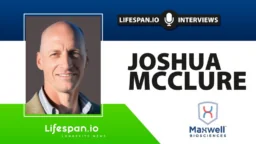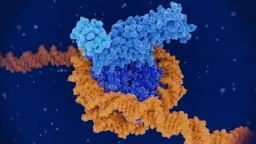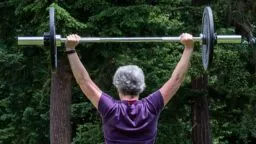It’s April Fool’s Day, but until we prevent our bodies from gradually deteriorating, the joke will always be on us. Here’s a no-fooling list of what’s been done to fight aging last month.
Interviews
 Joshua “Scotch” McClure: “Infectious Disease Drives Aging”: According to McClure, his company’s synthetic version of the ubiquitous but naturally unstable anti-microbial peptide LL-37 can fend off almost any infection, potentially leading to a considerable increase in human healthspan and lifespan.
Joshua “Scotch” McClure: “Infectious Disease Drives Aging”: According to McClure, his company’s synthetic version of the ubiquitous but naturally unstable anti-microbial peptide LL-37 can fend off almost any infection, potentially leading to a considerable increase in human healthspan and lifespan.
Research Roundup
Genes Affect Aging and Mortality Less Than Extrinsic Factors: A massive study from the University of Oxford has evaluated the relative impact of genetic and non-genetic factors on aging, mortality, and disease prevalence.
 Ginkgolide B Improves Healthspan and Lifespan in Female Mice: The authors of a recent study describe Ginkgolide B, a compound with senotherapeutic potential that improved muscle health, metabolism, frailty, inflammation, and senescence metrics and increased lifespan in female mice.
Ginkgolide B Improves Healthspan and Lifespan in Female Mice: The authors of a recent study describe Ginkgolide B, a compound with senotherapeutic potential that improved muscle health, metabolism, frailty, inflammation, and senescence metrics and increased lifespan in female mice.
A Klotho Gene Therapy Extends Life in Male Mice: In Molecular Therapy, a team of researchers has described how increasing the expression of a form of Klotho, a protein that has been frequently found to have rejuvenative effects, leads to longer lifespans in male mice.
 An Existing Diabetes Drug May Treat Aspects of Aging: In the Nature publication Signal Transduction and Targeted Therapy, researchers have described how glibenclamide, a drug used to treat type 2 diabetes, partially reverses epigenetic alterations and fights cellular senescence in mice.
An Existing Diabetes Drug May Treat Aspects of Aging: In the Nature publication Signal Transduction and Targeted Therapy, researchers have described how glibenclamide, a drug used to treat type 2 diabetes, partially reverses epigenetic alterations and fights cellular senescence in mice.
A New Study Claims to Challenge Peto’s Paradox: Applying statistical methods to a large dataset spanning almost 300 species, scientists found a positive correlation between body size and cancer prevalence.
 How Life Expectancy Has Changed in Europe: A recent country-level analysis of life expectancy among several European nations shows changes in life expectancy trends and how well-designed national policies can reduce or minimize exposure to risk factors, thus improving life expectancy.
How Life Expectancy Has Changed in Europe: A recent country-level analysis of life expectancy among several European nations shows changes in life expectancy trends and how well-designed national policies can reduce or minimize exposure to risk factors, thus improving life expectancy.
Human Exposome Project Explores Environmental Disease Causes: Recent research confirms the relatively minor role that genetics plays in our health, with the ‘exposome’, defined as the totality of exposures individuals experience over their lives affecting their health, responsible for 10 times more variation in mortality risk than genetic predisposition.
 Cellular Senescence Prevents Unlearning in Some Male Mice: In Aging Cell, researchers have established a link between cellular senescence and cognitive decline in unmodified male mice.
Cellular Senescence Prevents Unlearning in Some Male Mice: In Aging Cell, researchers have established a link between cellular senescence and cognitive decline in unmodified male mice.
Using a Surface Biomarker to Target Senescent Cells: Scientists have identified a senescence-associated surface protein that can be targeted using antibodies and published their work as a pre-print.
 Elamipretide, a Potential New Drug, Reduces Frailty in Mice: In Aging Cell, Dr. Vadim Gladyshev and a team of researchers have described how elamipretide beneficially affects mitochondrial pathways and reverses frailty in mice.
Elamipretide, a Potential New Drug, Reduces Frailty in Mice: In Aging Cell, Dr. Vadim Gladyshev and a team of researchers have described how elamipretide beneficially affects mitochondrial pathways and reverses frailty in mice.
Short-Term Overeating Alters Brain Insulin Sensitivity: A new study published in Nature Metabolism suggests that even a short period of eating loads of sweet and fatty snacks can cause brain changes reminiscent of those seen in obesity and type 2 diabetes.
 A Hypothalamus Neuropeptide Reduces Aging in a Mouse Model: Researchers have improved multiple health metrics in prematurely aged mice by re-establishing the production of neuropeptide Y in the hypothalamus.
A Hypothalamus Neuropeptide Reduces Aging in a Mouse Model: Researchers have improved multiple health metrics in prematurely aged mice by re-establishing the production of neuropeptide Y in the hypothalamus.
A Core Senescence Biomarker Fights Inflammation: Researchers publishing in Nature Communications have found that p53, a biomarker and inducer of senescence, suppresses both inflammation and DNA damage in senescent cells.
 Scientists Create Cytoskeleton-Like Structures From RNA: In a new study, researchers report producing self-assembling nanotubes and rings made from RNA molecules inside artificial cell-like lipid vesicles. In the future, this technology could facilitate the creation of synthetic cells for various research, diagnostic, and therapeutic applications.
Scientists Create Cytoskeleton-Like Structures From RNA: In a new study, researchers report producing self-assembling nanotubes and rings made from RNA molecules inside artificial cell-like lipid vesicles. In the future, this technology could facilitate the creation of synthetic cells for various research, diagnostic, and therapeutic applications.
Anti-Amyloid Drug Reduces Alzheimer’s Risk in Small Subgroup: According to an open-label study from Washington University in St. Louis, the anti-amyloid drug gantenerumab reduced the risk of developing familial Alzheimer’s disease in a subgroup of participants.
 Heat May Speed Up Epigenetic Aging in Older Adults: A recent study reported significant associations between increased heat days and accelerated epigenetic aging.
Heat May Speed Up Epigenetic Aging in Older Adults: A recent study reported significant associations between increased heat days and accelerated epigenetic aging.
Researchers Find New Target for Spinal Disc Degeneration: Researchers have found a new avenue for approaching spinal disc degeneration and published their work in Aging Cell.
 Need for Cholesterol May Explain Alzheimer’s Brain Patterns: Some brain regions are more vulnerable to Alzheimer’s disease than others. A new study suggests that this might be due to how they uptake cholesterol.
Need for Cholesterol May Explain Alzheimer’s Brain Patterns: Some brain regions are more vulnerable to Alzheimer’s disease than others. A new study suggests that this might be due to how they uptake cholesterol.
Changes in Aging Adrenal Glands Disturb Hormonal Balance: In the Journal of Endocrinological Investigation, reviewers have described how aging affects the adrenal glands, which has downstream effects on the rest of the human body.
Optimal dietary patterns for healthy aging: These findings suggest that dietary patterns rich in plant-based foods, with moderate inclusion of healthy animal-based foods, may enhance overall healthy aging, guiding future dietary guidelines.
Butter and Plant-Based Oils Intake and Mortality: Substituting butter with plant-based oils, particularly olive, soybean, and canola oils, may confer substantial benefits for preventing premature deaths.
Effectiveness of exercise for improving cognition, memory and executive function: a systematic umbrella review and meta-meta-analysis: These findings provide strong evidence that exercise, even light intensity, benefits general cognition, memory and executive function across all populations.
Home-based heat therapy lowers blood pressure and improves endothelial function in older adults: This could be an alternative nonpharmacological intervention to reduce blood pressure and improve vascular function.
Effects of a natural ingredients-based intervention targeting the hallmarks of aging on epigenetic clocks, physical function, and body composition: These findings suggest that the Cel System supplement range may effectively reduce biological age and improve health metrics
Citrulline regulates macrophage metabolism and inflammation to counter aging in mice: These findings underscore the significance of citrulline deficiency as a driver of aging, highlighting citrulline supplementation as a promising therapeutic intervention.
Metformin and physical performance in older people with probable sarcopenia and physical prefrailty or frailty in England (MET-PREVENT): Metformin did not improve 4-m walk speed and was poorly tolerated in this population.
Neuroprotective effects of SGLT2 inhibitors empagliflozin and dapagliflozin on Aβ1–42-induced neurotoxicity and neuroinflammation in cellular models of Alzheimer’s disease: SGLT2i significantly reduced Aβ1–42-induced reactive oxygen species generation, downregulated NLRP3-inflammasome, and diminished tau pathology.
Sildenafil and risk of Alzheimer disease: a systematic review and meta-analysis: This meta-analysis showed that the use of Sildenafil is associated with a reduced risk of developing AD by two-fold.
Genetically supported targets and drug repurposing for brain aging: A systematic study in the UK Biobank: This study provides insights into the genetic basis of brain aging, potentially facilitating drug development for brain aging to extend healthspan.
Drug-Based Lifespan Extension in Mice Strongly Affects Lipids Across Six Organs: This finding implies that lifespan-extending treatments tend to reverse metabolic phenotypes to a biologically younger stage.
A torpor-like state in mice slows blood epigenetic aging and prolongs healthspan: These findings provide novel mechanistic insight into the decelerating effects of torpor and hibernation on aging
Small extracellular vesicles from young adipose-derived stem cells ameliorate age-related changes in the heart of old mice: These results denote the potential of ADSC-sEVs as a novel, noninvasive therapeutic strategy for mitigating cardiac aging-associated functional decline.
Senolytic treatment for low back pain: Together, these data suggest RG-7112 and o-vanillin as potential disease-modifying drugs for LBP and other painful disorders linked to cell senescence.
Low-intensity pulsed ultrasound inhibits chondrocyte senescence by inhibiting PI3K/AKT/mTOR signaling: findings expanded the clinical application of LIPUS and provide a new, non-invasive, and safe treatment approach to prevent and treat age-related degenerative joint disorders.
Rejuvenation of Senescent Cells, In Vitro and In Vivo, by Low-Frequency Ultrasound: These results indicate that mechanically induced pressure waves alone can reverse senescence and aging effects at the cellular and organismal level.
Reprogramming to restore youthful epigenetics of senescent nucleus pulposus cells for mitigating intervertebral disc degeneration and alleviating low back pain: Collectively, reprogramming by the OKS@M-Exo to restore youthful epigenetics of senescent NPCs may hold promise as a therapeutic platform to treat IVDD.
News Nuggets
 Event Announcement: Longevity Science Summit: The Longevity Science Foundation (LSF) has organized the Longevity Science Summit in Miami – the future hub of longevity sciences in the United States.
Event Announcement: Longevity Science Summit: The Longevity Science Foundation (LSF) has organized the Longevity Science Summit in Miami – the future hub of longevity sciences in the United States.
LongX Launches 2nd Edition of the Xplore Program: LongX, an initiative dedicated to providing avenues into the longevity space, announced a call for applications for the 2025 Xplore Program.
 Rejuve.AI Launches App for Longevity Advice and Treatments: Longevity research network Rejuve.AI has launched Rejuve Longevity, an app that combines AI, cutting-edge research and blockchain technology to widen access to longevity treatments and advice.
Rejuve.AI Launches App for Longevity Advice and Treatments: Longevity research network Rejuve.AI has launched Rejuve Longevity, an app that combines AI, cutting-edge research and blockchain technology to widen access to longevity treatments and advice.



